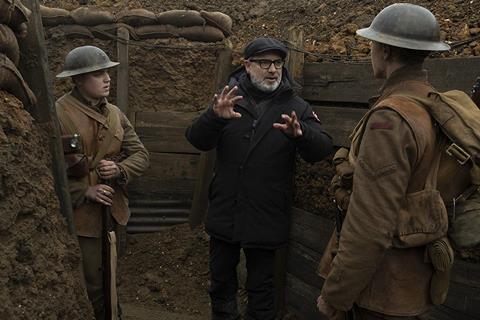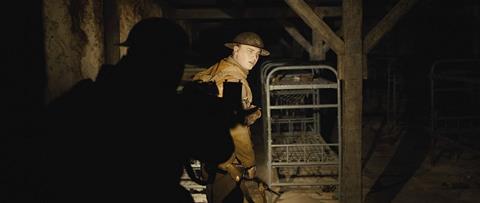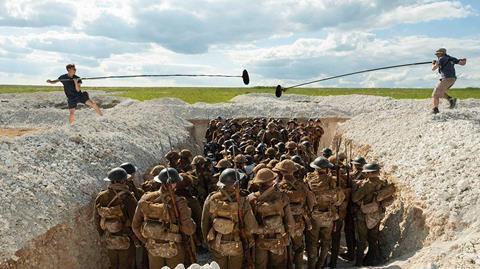Meticulous military planning was required for Sam Mendes’ clock-ticking ‘one-shot’ war drama. Adrian Pennington talks to cinematographer Roger Deakins and sound mixer Stuart Wilson.

The risk in composing a nearly two-hour feature as if shot in one continuous sequence is that it will do the polar opposite of its immersive intent and draw attention to itself.
“We would fail if the technique became the distraction,” admits Roger Deakins ASC BSC. “But if you don’t take risks then why do it all?”
The one-shot aesthetic, either without cuts or with edits cleverly masked to conceal their join, has a history as far back as Alfred Hitchcock’s studio-bound Rope in 1948 stretching through Oscar winner Birdman in 2014 and Norwegian drama Blind Spot (2018) but none has had the epic scale, nor arguably more visceral impact, than 1917.
For director Sam Mendes, who co-wrote the screenplay, this treatment was the best way to give viewers a sense of walking in the footsteps of two young soldiers facing relentless danger as they cross enemy lines and race against time.
“Sam wanted the audience to feel that they are with these characters all the time,” Deakins explains. “People have said it resembles a video game but I don’t know - I don’t play them.”
He adds: “For me, it was about not giving the audience a release from the violent and disorienting environment the characters are in. So, we don’t give them a wide shot, everything is from the character’s perspective, there’s no get-out clause. For me, it feels right for this project because our characters and therefore the camera is always on the move.”

Deakins spent longer preparing for this project – ten months - than on almost any other in his storied career.
“We began by talking about the approach - the feeling of the camera,” he explains. “We then worked with a storyboard artist to sketch out storyboards for different sequences, exploring different ideas for how to move the camera and where to move the camera to hit particular parts of the sequence. During rehearsal with the actors we finessed what we wanted to show and what we didn’t, and with [production designer] Dennis Gassner we mapped how the cameras would move through the sets.
“For example, we had to work out the length of the trenches and how we would enter and exit the farmhouse that was going to be built. We mapped out the relationship between the burnt copse and the farmhouse and how big the orchard needed to be and how far that was from the farmhouse. Everything had to work for the action and for the camera.”
The joint-up effect
There have been bravura cinematic stunts like Russian Ark and Victoria which pulled off an uninterrupted Steadicam shot for their entire runtime but that wasn’t possible for 1917 given the need to use different locations. These included an old airfield near Hemel Hempstead, Salisbury Plain (The film shot largely on location in the south of England UK (doubling for scenes of the western front in Ypres, Belgium) and the Govan Docks in Glasgow.
Instead, Deakins had to work out how to join these locations together as well as figuring out how one shot fitted to the next.
“It had to match perfectly,” he says. “For instance, a scene depicting them crossing the canal was partly shot in Glasgow and for that, we needed a camera system wired above the water. At one point the camera is taken off the wire and handheld while remotely operated. That shot needed to join with the previous shot and also join with the upcoming shot.
“We could only sustain these sequences for so long. To get perfect seven or nine-minute takes from beginning to end is quite a stretch with complicated camera movement and all the other visual effects and performances, so we broke it down into manageable chunks.”
One of the bigger issues was receiving transmission signals from a camera operating either hundreds of yards away or deep in a 7 ft trench, or both.
“My DIT needed a calibrated image on his monitor, I needed to see to what the camera was seeing and Andy Harries (first AC and focus puller) had to have connectivity with the focus mechanism on the camera.
“I operated about 60% of the picture remotely but sometimes our key grips Gary Hymns and Malcolm McGilchrist were carrying the camera or it was on a crane or a wire. At one point we had it on a motorbike.
“It was a dance between whoever is carrying the camera, and the actors and myself operating.”
- Read more: Who is the greatest cinematographer ever?
Epic scope
Mendes wanted to produce an IMAX version of his film and agreed with Deakins that a large format camera would capture the epic scope of the drama. The last time the pair worked together was on Skyfall, for which Deakins landed one of his fourteen nominations, using an ARRI digital camera.
“I liked the large format of the Alexa LF, but the body was too big and heavy for our purposes,” he says. “Luckily, we approached them just as they were developing a mini version of the camera and I said we’ll shoot the whole movie on them if you can guarantee you’ll have it ready in time.”
ARRI accelerated development and handed the production the first three prototype bodies of the Alexa Mini LF.
“It was the sense that you could shoot with a longer lens, get less depth of field, but still maintain the width of view,” says Deakins of the full-frame system. “I don’t like shooting close-ups of people on wide lenses but I shot nearly all of it on a 40mm. That’s what drew me to it, really, the idea of shooting on a 40 mm but getting the background at the same time.
“In my mind, it looks like the still photos of that era and of the images of the first World War.”
The camera needed to be very small and lightweight so that they could use it on the stabilising systems necessary to make the long and complex camera moves. Charlie Rizek operated the ARRI Trinity, a hybrid rig that combines classic mechanical stabilisation with active electronic stabilisation, while Deakins’ regular operator Pete Cavaciuiti orchestrated Steadicam.

Weather or not
Any film needs to maintain consistency from scene to scene but with the bulk of 1917 shot on location, and in scene order, they were fingers crossed that the weather would hold. The production even employed a chief meteorologist.
“I’ve shot many films where you shoot the scene regardless of whether it is sunny or cloud because you have to stick to the schedule and you can find a way of making it work but here you couldn’t. It wasn’t possible to have one shot in full sunlight and the next in heavy cloud. Any shift when we blend one scene to another would really stand out in the edit.”
With first assistant director Michael Lerman, Deakins worked out what time of day was best to shoot each shot. He also worked with Gassner to design trenches on Salisbury Plain that would be angled in the best way for the light at the right time of day.
“The interiors were all lit but this was complicated because the cameras are always seeing 360-degrees so you can’t do anything conventionally,” he says.
The very last shot of the film was particularly satisfying for Deakins. “The audience may not notice, but we were trying to time the shot for the sun to come out of the cloud and it did, just where I wanted it to. For me, that was gold dust.”
The one-shot effect lives or dies in the edit bay. Lee Smith, ACE (Oscar winner for time-hopping World War II drama Dunkirk) received the movie in giant, story-ordered chunks so he could watch it come together in real time. He played a key role in helping Mendes assess which takes worked best and whether the concept was working at all.
- Read more: Craft Leaders - Lee Smith, Editor
Smith’s challenge was having no other angles (coverage) to play with, no license to cut out or around anything and no leeway in making the appearance of the single take as seamless as possible.
“Conventionally you can always hide something if it doesn’t work,” Smith told CinemaEditor. “You can pick up a shot later, you might go wide or close-up, reverse the cut, play it all in a master or all in tight. There are a million ways you can exit a scene but this film didn’t offer up those choices. It had to work perfectly every time. That’s very high pressure.”
To help in this endeavour he brought on board a sound team much earlier in the process than normal, to add music and comp out camera equipment, to get as close as possible to a finished shot as possible during principal photography.
“We had to be completely confident in the process because there wasn’t a fix we could make later. Tension and pace are the hardest things to adjust. It’s what I was always keeping my eye on.”
Mics, movement and mud
Meticulous military planning was also required of the production’s sound team.
Production sound mixer Stuart Wilson joined other heads of department many months before principal photography to give sound the best shot at being designed into the fabric of the shoot.
“Sam is all about the performance,” Wilson says. “We have to take our lead from what the actors are doing and prep the site according to where they were going to be without getting in the way of the process.”
Not so easy when filming lengthy takes of actors travelling up to half a mile or more from their starting point.
“My first thought was to carry my recorder following the blind spot behind the cameras and just be close to the action at all times,” he explains. “During a proof of concept we would block the shots with actors in an approximation of the space and I realised I’d be adding another set of unwanted footsteps into the sound of the characters moving through mud.”
He elected instead to install a network of antenna across the geography of each shot and to send a live mix of the dialogue back to key crew.
“It’s essential that the special FX supervisor, script supervisor, camera crew and director hear what is happening in the scene, especially when the actors will often be out of line of sight. I approached each scene like a series of site installations.”
Hidden sounds
With costume designer Jacqueline Durran, Wilson experimented with different fabrics to hide wireless lavalier mics on the actors, testing the noise of various wool and leather materials.
First assistant sound and former gymnast Hugh Sherlock was hired to operate the boom because of his ability to keep up with the action running backwards and nimbly on the edge of trenches.
Working with the drapes department Wilson made use of materials from the set dressing, such as sandbags, to disguise antenna in trees, piles of mud, munitions boxes.
“We’ve got takes of six or eight minutes and if something wasn’t quite right we’d have to go again but once you started a take you can’t stop, you have to improvise,” he says. “Each take was like a piece of theatre.”
Relaying sound at distances beyond 100m away over copper cable risked attenuation so Wilson installed fibre optics linking antenna back to the receiver where he would monitor remotely alongside Deakins. His principal kit was a pair of Cantar X3 24-track location audio mixers and wireless antenna/receivers from Wisycom.

“Sometimes the action would start out of sight over a hill. We’d have splitters and combiners to extend the network over wider areas.”
Having worked with Deakins on Skyfall, Wilson found it easy to convince the camera and video team to employ low powered transmitters. “Sometimes you can get crew using high powered camera transmitters which will interfere with sound wireless frequencies,” he says. He also assisted in reducing the noise of the Trinity camera rig.
The cast of extras and background characters were all given authentic actions during each sequence so Wilson planted mics beyond the frame to extend the soundscape.
“As the camera swings around you can hear things before you see them,” he says. “Sam’s principal aim with the sound is to fuse an intimate connection between the audience and the lead characters. He wanted to avoid re-recording dialogue and to use the energy and actuality of the performance as experienced on site.”
At some points, lead actor George MacKay carried four wireless mics and two body-worn recorders. The back-up recorders were used for a scene in which his character falls into a river.
“We had to maintain continuous recording so we could retrieve the recorders later and rebuild the sound. With wireless personal mics, you can zoom in in post and decide creatively whether you want to be close to a particular character or to dial back and see them placed more in the landscape.”
Multiple mics were also necessary in order to catch lines of dialogue spoken in a 360-degree camera move where different mics would pick up the sound better as the actor’s position changed.
Wilson’s experience working on WW1 drama War Horse (2011) helped him prepare for recording sound in the mud.
“One minute I’m in the mixing van, the next I’m lifting up duckboard on the mud to put more woodchip underneath because the footsteps were too squelchy.”
A farm building on location was used as a set for some interiors. “It was acoustically terrible so we had to bring in a silent roofing system to go over the top.”
Filming on Salisbury Plain on land belonging to the MOD was a bonus. “It’s a sound person’s dream,” he says. “Hardly anyone lives there and it’s as if we’d been dropped into this wilderness free to stage it for our story. We could even arrange a no-fly zone which is a rarity on any shoot. The only downside was we could hear live shelling from real army training – but it didn’t impact sound recording too much.”
- Read more: Behind the scenes: The Irishman




























No comments yet